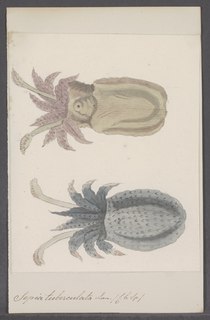Sepia adami is a species of cuttlefish native to the southwestern Indian Ocean. It is known only from the type locality, S 79ºE off Cape Natal. It lives at a depth of up to 99 m.
Sepia angulata is a species of cuttlefish native to the southeastern Atlantic Ocean, from Bloubergstrand to Still Bay. It is known only from cuttlebones. The validity of S. angulata has been questioned.
Sepia confusa is a species of cuttlefish native to the southwestern Indian Ocean, specifically southeastern Africa from Port Elizabeth to southern Mozambique, Zanzibar and Pemba, and Madagascar. S. confusa has also been erroneously recorded from the Arabian Sea. A record from the Saya-de-Malha Bank has not been confirmed by recent expeditions. The species lives at a depth of between 53 and 352 m.
Sepia dubia is a species of cuttlefish native to the southeastern Atlantic Ocean. It is known only from the type locality, where it was caught at a depth of 25 m.
Sepia elongata is a species of cuttlefish native to the northwestern Indian Ocean, specifically from the Red Sea to Somalia. The depth range of S. elongata is unknown.
Sepia erostrata is a species of cuttlefish native to the northwestern Pacific Ocean, specifically off western mainland Japan, from Sagami Bay to the Kii Peninsula. It inhabits subtidal, inshore habitats. It is the commonest species of cuttlefish occurring in rocky shorelines around Japanese coasts.
Sepia faurei is a species of cuttlefish native to the southwestern Indian Ocean, specifically to the east of the Cape of Good Hope, South Africa. It lives at depths to 168 m.
Sepia hieronis is a species of cuttlefish native to the southeastern Atlantic Ocean and southwestern Indian Ocean, specifically southern Namibia, from approximately 27°S to Port Alfred, South Africa, and east Africa from 17°S to Kenya and Mozambique. It is also present in the Saya-de-Malha Bank. It lives at depths of between 43 and 500 m, although it is most abundant at 110 to 250 m depth.
Sepia incerta is a species of cuttlefish native to the southwestern Indian Ocean, specifically south and east Africa, from Port Elizabeth to Mozambique. It is also present in the Saya-de-Malha Bank. S. incerta lives at a depth of between 90 and 345 m.
Sepia insignis is a species of cuttlefish native to the southwestern Indian Ocean, specifically South Africa, from the Cape of Good Hope to Natal. It lives at depths to 42 m.
Sepia ivanovi is a species of cuttlefish native to the southwestern Indian Ocean, probably throughout southeast Africa, including Kenya, Mozambique, to the mouth of the Zambezi River. It lives at depths to 50 m.
Sepia joubini is a species of cuttlefish native to the southwestern Indian Ocean, specifically South Africa, off Tugela River Mouth, to Cape Natal, off southern Mozambique, and in the Saya-de-Malha Bank. It lives at a depth of between 66 and 170 m.

Sepia papillata is a species of cuttlefish native to the southeastern Atlantic Ocean and southwestern Indian Ocean. Its natural range stretches from Lüderitz Bay, South Africa, to the coast of KwaZulu-Natal off the Tugela and Umvoti Rivers. It is also present in Mascarene Ridge. It lives at depths of between 26 and 210 m.
Sepia pardex is a species of cuttlefish native to the western Pacific Ocean, specifically off Japan, along the Pacific coast from the Chiba Peninsula, and along the Japan Sea coast from Toyama Bay to South Korea. It is also present off Taiwan and in the East China Sea. The depth range of this species is unknown.
Sepia robsoni is a species of cuttlefish known only from its type locality, Hout Bay in South Africa. Its lives at depths of between 17 and 37 m.
Sepia simoniana is a species of cuttlefish native to the western Indian Ocean. Its natural distribution stretches from Cape Town to Agulhas Bank, north to northern Kenya and southern Mozambique. It is also present in the Saya-de-Malha Bank. S. simoniana usually lives at depths of less than 100 m, although it has been recorded down to 190 m.
Sepia tala is a species of cuttlefish native to the southwestern Indian Ocean, specifically southwestern Madagascar off Cape Tala. It is known only from the type locality. S. tala lives at depths of 325 to 332 m.
Sepia tenuipes is a species of cuttlefish native to the western Pacific Ocean. Its natural range covers the waters off eastern Honshū and the western Japan Sea to the south of Kyūshū, the East China Sea, and Korea. S. tenuipes lives at depths of 100 to 250 m.

Sepia tuberculata is a species of cuttlefish native to South African waters from Melkbosstrand to Knysna. It belongs to the genus Sepia. It lives in very shallow water to a depth of 3 m. It is endemic.

Sepia typica is a species of cuttlefish native to the southwestern Indian Ocean and southeastern Atlantic Ocean. Its natural range stretches from Saldanha Bay, South Africa to southern Mozambique. It lives at depths of 2 to 290 m.


